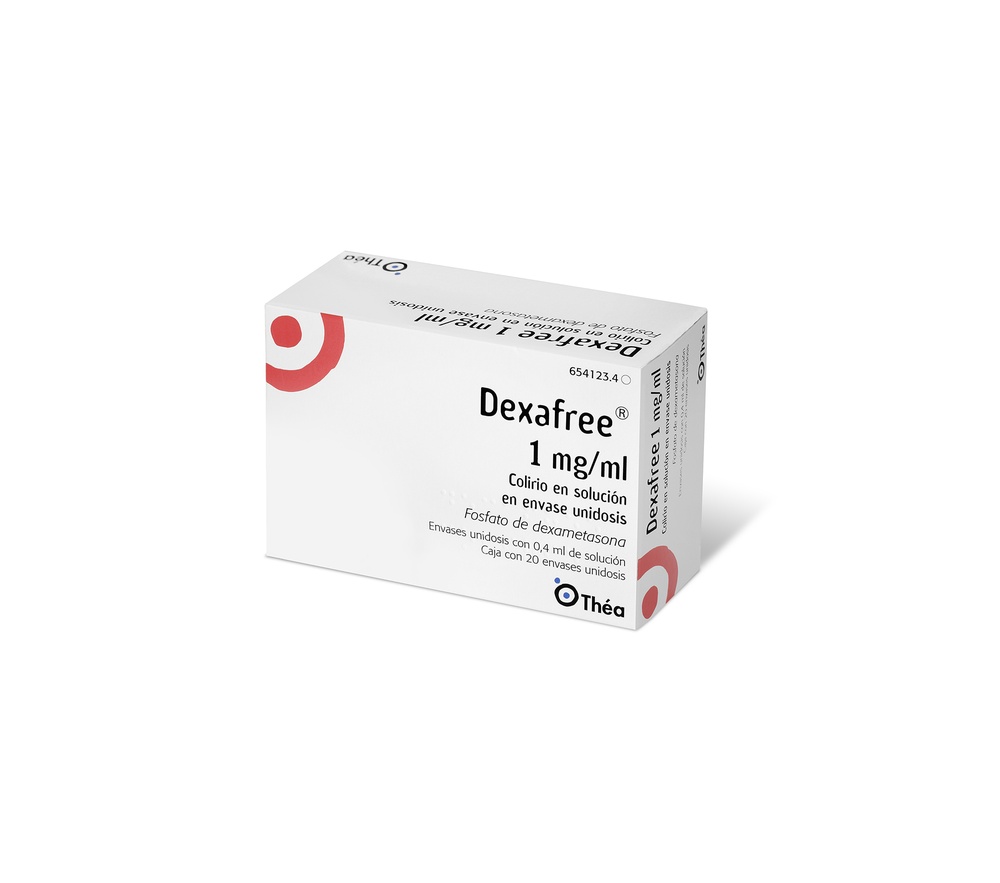

ДЕКСАФРИ 1 мг/мл ГЛАЗНЫЕ КАПЛИ В РАСТВОРЕ В ОДНОДОЗОВЫХ КОНТЕЙНЕРАХ

Спросите врача о рецепте на ДЕКСАФРИ 1 мг/мл ГЛАЗНЫЕ КАПЛИ В РАСТВОРЕ В ОДНОДОЗОВЫХ КОНТЕЙНЕРАХ

Инструкция по применению ДЕКСАФРИ 1 мг/мл ГЛАЗНЫЕ КАПЛИ В РАСТВОРЕ В ОДНОДОЗОВЫХ КОНТЕЙНЕРАХ
Введение
Инструкция: информация для пользователя
DEXAFREE 1 мг/мл, глазные капли в растворе в однодозовом контейнере
Фосфат дексаметазона
Прочитайте внимательно всю инструкцию перед началом использования этого лекарства, поскольку она содержит важную информацию для вас.
- Сохраните эту инструкцию, поскольку вам может потребоваться прочитать ее снова.
- Если у вас есть какие-либо вопросы, проконсультируйтесь с вашим врачом или фармацевтом.
- Это лекарство было назначено только вам, и не передавайте его другим людям, даже если у них такие же симптомы, как у вас, поскольку оно может нанести им вред.
- Если вы испытываете побочные эффекты, проконсультируйтесь с вашим врачом или фармацевтом, даже если это побочные эффекты, которые не указаны в этой инструкции. См. раздел 4.
Содержание инструкции
- Что такое Dexafree и для чего он используется
- Что вам нужно знать перед началом использования Dexafree
- Как использовать Dexafree
- Возможные побочные эффекты
- Хранение Dexafree
- Содержание контейнера и дополнительная информация
1. Что такое Dexafree и для чего он используется
Dexafree - это глазные капли в растворе в однодозовых контейнерах, содержащие вещество под названием дексаметазон. Это вещество является кортикостероидом, который подавляет воспалительные симптомы.
Dexafree показан для лечения воспаления глаза (глаз).
Глаз не должен быть инфицирован (красный глаз, выделения, слезотечение и т. д.); в противном случае, это лекарство должно быть комбинировано с специальным лечением для вашей инфекции (см. раздел 2).
2. Что вам нужно знать перед началом использования Dexafree
Не используйте Dexafree:
• Если у вас есть инфекция глаза, которая может быть бактериальной (острая гнойная инфекция), грибковой, вирусной (вирус простого герпеса, вирус вакцины, вирус варицеллы-зостера) или амебной.
• Если у вас есть повреждение роговицы(прободение, язвы или повреждения, связанные с неполным заживлением).
• Если у вас есть высокое внутриглазное давление, вызванное глюкокортикоидами (семейством кортикостероидов)
• Если вы аллергичны(гиперчувствительны) к фосфату дексаметазонаили к любому другому компоненту Dexafree.
Предостережения и меры предосторожности
Проконсультируйтесь с вашим врачом или фармацевтом перед началом использования Dexafree
НЕ ВСТРИКАТЬ, НЕ ПРИНИМАТЬ ВНУТРЬ
Избегайте контакта кончика контейнера с глазом или веками.
- Если вы используете Dexafree, вы должны находиться под строгим контролем вашего офтальмолога в любом случае и, в частности:
- Для детей и пожилых людей рекомендуется более частый офтальмологический контроль.
- Если у вас есть глазная инфекция, вы должны использовать Dexafree только в том случае, если инфекция контролируется с помощью противоинфекционного лечения.
- Если у вас есть язва роговицы, не используйте местное лечение дексаметазоном или Dexafree, если только воспаление не является причиной задержки заживления.
- Если у вас есть высокое внутриглазное давление или если вы ранее реагировали на увеличение внутриглазного давления после предыдущего лечения стероидами, у вас есть риск увеличения внутриглазного давления, если вы будете лечиться Dexafree.
- Если у вас есть глаукома.
- Дети: Избегайте длительного лечения.
- Тяжелая аллергическая конъюнктивит: Если у вас есть тяжелая аллергическая конъюнктивит, которая не реагирует на стандартную терапию, вы должны использовать Dexafree только в течение коротких периодов времени.
- Сахарный диабет: Если вы страдаете сахарным диабетом, вы должны сообщить об этом вашему офтальмологу.
- Красный глаз: Не используйте Dexafree в случае нераспознанного красного глаза.
- Контактные линзы: Вы должны избегать использования контактных линз во время лечения Dexafree.
Проконсультируйтесь с вашим врачом, если вы испытываете отек и увеличение веса вокруг туловища и лица, поскольку это, как правило, первые проявления синдрома, называемого синдромом Кушинга. Может произойти подавление функции надпочечников после прекращения интенсивного или длительного лечения Dexafree. Проконсультируйтесь с вашим врачом перед прекращением лечения по вашей инициативе. Эти риски особенно важны для детей и пациентов, леченных препаратом ритонавир или кобикистат.
Свяжитесь с вашим врачом, если вы испытываете размытое зрение или другие нарушения зрения.
Использование Dexafreeс другими лекарствами:
В случае лечения в сочетании с другим глазным раствором расстояние между инстилляциями должно быть не менее 15 минут.
Сообщите вашему врачу, если вы принимаете ритонавир или кобикистат, поскольку это может привести к увеличению количества дексаметазона в крови. Были описаны отложения фосфата кальция в роговице во время совместного использования кортикостероидов и местных бета-блокаторов.
Сообщите вашему врачу или фармацевту, если вы используете или最近 использовали или можете использовать любое другое лекарство.
Беременность и лактация
Недостаточно данных о использовании Dexafree у беременных женщин, чтобы оценить возможные вредные эффекты.
По этой причине не рекомендуется использовать Dexafree во время беременности.
Неизвестно, выделяется ли это лекарство в грудное молоко. Однако общая доза дексаметазона низка.
Следовательно, Dexafree может быть использован во время лактации.
Если вы беременны или кормите грудью, считаете, что могли бы быть беременной или планируете стать беременной, проконсультируйтесь с вашим врачом или фармацевтом перед использованием этого лекарства.
Вождение и использование машин:
Как и все глазные капли, временное размытое зрение или другие нарушения зрения могут повлиять на способность управлять транспортными средствами или использовать машины. Если возникает размытое зрение, пациент должен подождать, пока зрение не станет ясным, прежде чем управлять транспортными средствами и использовать машины.
Спортсмены
Спортсменам сообщают, что это лекарство содержит компонент, который может дать положительный результат в тестах на допинг.
Dexafree содержит фосфаты
Это лекарство содержит 80 микрограммов фосфатов в каждой капле.
3. Как использовать DEXAFREE
Дозировка
Следуйте точно инструкциям по применению этого лекарства, указанным вашим врачом. В случае сомнений проконсультируйтесь с вашим врачом или фармацевтом снова
Рекомендуемая доза - 1 капля, 4-6 раз в день в пораженный глаз. В тяжелых случаях лечение может быть начато с 1 капли каждый час и должно быть снижено до 1 капли каждые 4 часа, когда будет наблюдаться положительная реакция. Рекомендуется постепенное прекращение лечения, чтобы избежать рецидива.
Использование у пожилых людей
У пожилых людей не требуется коррекция дозы.
Использование у детей и подростков
У детей следует избегать длительного использования.
Метод применения
Глазное применение: это лекарство предназначено для введения в глаз.
?Мойте рукитщательно перед использованием продукта.
?Наклоните голову немного назад с взглядом, направленным вверх.
Потяните за указательный палец вашей свободной руки нижнее веко вниз от пораженного глаза.
Аккуратно нанесите одну каплю в конъюнктивальный мешок.
?После применения слегка нажмитена слезный проток в течение нескольких минут (чтобы уменьшить риск системных реакций и увеличить проникновение активного вещества в глаз).
?Утилизируйтекаждый однодозовый контейнер после его использования. Не сохраняйте его для повторного использования.
Частота применения
4-6 раз в день.
Продолжительность лечения
Продолжительность лечения может варьироваться от нескольких дней до максимума 14 дней.
Если вы использовали больше Dexafree, чем следует:
Если вы ввели слишком много продукта в ваш глаз и если вы заметили постоянное ощущение раздражения, промойте глаз стерильной водой.
Свяжитесь с вашим врачом или фармацевтом немедленно.
Если вы пропустили использование Dexafree:
Не используйте двойную дозу, чтобы компенсировать пропущенную дозу.
Если вы прекратили лечение Dexafree:
Не прекращайте лечение внезапно. Проконсультируйтесь с вашим врачом, если вы решите завершить лечение.
Если у вас есть какие-либо другие вопросы об использовании этого лекарства, проконсультируйтесь с вашим врачом или фармацевтом.
4. Возможные побочные эффекты
Как и все лекарства, это лекарство может вызывать побочные эффекты, хотя не все люди испытывают их.
Эндокринные расстройства
- Частота не известна: не может быть оценена на основе доступных данных.
- Гормональные проблемы: чрезмерный рост волос на теле (особенно у женщин), слабость и истощение мышц, полосы на коже, повышение артериального давления, нерегулярные или отсутствующие менструации, изменения в уровнях белка и кальция в организме, задержка роста у детей и подростков и отек и увеличение веса тела и лица (синдром Кушинга) (см. раздел 2, «Предостережения и меры предосторожности»).
Глазные расстройства:
- Очень часто: могут поражать более 1 из 10 человек
- Увеличение внутриглазного давления после 2-недельного лечения.
- Часто: могут поражать до 1 из 10 человек
- Неприятные ощущения, раздражение, жжение, зуд, щекотка и размытое зрение после инстилляции.
Эти симптомы обычно являются временными и легкими
- Редко: могут поражать до 1 из 100 человек
- Аллергические реакции и гиперчувствительность к любому компоненту глазных капель,
- задержка заживления ран,
- помутнение хрусталика (катаракта)
- инфекции,
- глаукома
- Очень редко: могут поражать до 1 из 10 000 человек.
- воспаление глазных оболочек (конъюнктивит)
- расширение зрачка (мидриаз)
- отек (отек лица)
- птоз (птоз век)
- воспаление радужной оболочки (увеит)
- кальцификация роговицы
- воспаление роговицы (кристаллическая кератопатия)
- изменения в толщине роговицы
- отек роговицы
- язва роговицы
- прободение роговицы
Если у вас есть тяжелое повреждение прозрачной оболочки передней части глаза (роговицы), лечение фосфатами в редких случаях может привести к образованию мутных пятен на роговице из-за кальция.
Сообщение о побочных эффектах
Если вы испытываете любой побочный эффект, проконсультируйтесь с вашим врачом или фармацевтом, даже если это возможные побочные эффекты, которые не указаны в этой инструкции. Вы также можете сообщить об этом напрямую через систему фармаковигиланса: www.notificaRAM.es. Сообщая о побочных эффектах, вы можете внести свой вклад в предоставление более полной информации о безопасности этого лекарства.
5. Хранение Dexafree
Храните это лекарство в недоступном для детей месте.
Не используйте это лекарство после даты истечения срока годности, указанной на каждом однодозовом контейнере после EXP. Дата истечения срока годности - последний день месяца, указанного.
После первой открытия блистера: используйте контейнер в течение 15 дней после открытия.
После открытия контейнера: используйте сразу и утилизируйте контейнер после использования.
Храните контейнеры в блистере, чтобы защитить их от света.
Лекарства не должны выбрасываться в канализацию или мусор. Поместите контейнеры и лекарства, которые вам больше не нужны, в пункт сбора SIGRE в аптеке. Если у вас есть сомнения, спросите вашего фармацевта, как избавиться от контейнеров и лекарств, которые вам больше не нужны. Таким образом, вы поможете защитить окружающую среду.
6. Содержание контейнера и дополнительная информация
Состав Dexafree
Активное вещество - фосфат дексаметазона.
Каждый миллилитр раствора содержит 1 мг фосфата дексаметазона (в виде фосфата дексаметазона и натрия).
Другие компоненты - эдетат динатрия, дигидrogenофосфат динатрия дodecahydrate, хлорид натрия и вода для инъекций.
Внешний вид продукта и содержание контейнера
Dexafree - это глазные капли в виде бесцветного или слегка коричневого раствора, представленные в однодозовых контейнерах.
Каждый контейнер содержит 0,4 мл раствора. Коробка содержит 10, 20, 30, 50 или 100 контейнеров, упакованных в блистеры.
Владелец разрешения на продажу и ответственный за производство
Владелец: Laboratoires Théa S.A.
12, rue Louis Blériot
63017 Clermont-Ferrand Cedex 2
(Франция)
Местный представитель:
Laboratorios Thea S.A.
C/ Enric Granados, nº 86-88, 2ª planta
, 08008 Barcelona
Ответственный за производство:
EXCELVISION
Rue de la Lombardière, 07100 Annonay, (Франция)
Или
Laboratoires UNITHER
1 rue de l’Arquerie,
50200 Coutances
(Франция)
Это лекарство разрешено в странах-членах Европейского экономического пространства под следующими названиями:
Болгария, Кипр, Франция, Греция, Ирландия, Польша, Португалия, Испания и Великобритания ……………………………… DEXAFREE
Бельгия, Нидерланды и Люксембург ………….. MONOFREE DEXAMETHASON
Германия и Австрия ……………………………………… MONODEX
Италия и Словения ……………………………………. DEXAMONO
Дания, Финляндия, Норвегия и Швеция ………………. MONOPEX
Дата последнего пересмотра этой инструкции: Август 2018
Подробная информация о этом лекарстве доступна на сайте Агентства по лекарственным средствам и медицинским изделиям (AEMPS)
http://www.aemps.es
- Страна регистрации
- Активное вещество
- Требуется рецептДа
- Производитель
- Информация носит справочный характер и не является медицинской рекомендацией. Перед приемом любых препаратов проконсультируйтесь с врачом. Oladoctor не несет ответственности за медицинские решения, принятые на основе этого контента.
- Аналоги ДЕКСАФРИ 1 мг/мл ГЛАЗНЫЕ КАПЛИ В РАСТВОРЕ В ОДНОДОЗОВЫХ КОНТЕЙНЕРАХФорма выпуска: ГЛАЗНЫЕ КАПЛИ, 1 мг/млАктивное вещество: ДексаметазонПроизводитель: Pharmaselect International Beteiligungs GmbhТребуется рецептФорма выпуска: ГЛАЗНЫЕ КАПЛИ, 0,1 %Активное вещество: ДексаметазонПроизводитель: Fidia Farmaceutici S.P.A.Требуется рецептФорма выпуска: ГЛАЗНЫЕ КАПЛИ, 1 мг/млАктивное вещество: ДексаметазонПроизводитель: Brill Pharma S.L.Требуется рецепт
Аналоги ДЕКСАФРИ 1 мг/мл ГЛАЗНЫЕ КАПЛИ В РАСТВОРЕ В ОДНОДОЗОВЫХ КОНТЕЙНЕРАХ в других странах
Лучшие аналоги с тем же действующим веществом и терапевтическим эффектом.
Аналог ДЕКСАФРИ 1 мг/мл ГЛАЗНЫЕ КАПЛИ В РАСТВОРЕ В ОДНОДОЗОВЫХ КОНТЕЙНЕРАХ в Poland
Аналог ДЕКСАФРИ 1 мг/мл ГЛАЗНЫЕ КАПЛИ В РАСТВОРЕ В ОДНОДОЗОВЫХ КОНТЕЙНЕРАХ в Ukraine
Врачи онлайн по ДЕКСАФРИ 1 мг/мл ГЛАЗНЫЕ КАПЛИ В РАСТВОРЕ В ОДНОДОЗОВЫХ КОНТЕЙНЕРАХ
Консультация по дозировке, побочным эффектам, взаимодействиям, противопоказаниям и продлению рецепта на ДЕКСАФРИ 1 мг/мл ГЛАЗНЫЕ КАПЛИ В РАСТВОРЕ В ОДНОДОЗОВЫХ КОНТЕЙНЕРАХ – по решению врача и с учетом местных правил.














